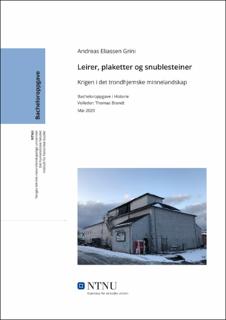| dc.contributor.advisor | Brandt, Thomas | |
| dc.contributor.author | Grini, Andreas Eliassen | |
| dc.date.accessioned | 2021-09-13T16:00:46Z | |
| dc.date.available | 2021-09-13T16:00:46Z | |
| dc.date.issued | 2020 | |
| dc.identifier | no.ntnu:inspera:57493347:29992787 | |
| dc.identifier.uri | https://hdl.handle.net/11250/2775479 | |
| dc.description.abstract | Minnestudier er en retning innenfor historiefaget, som i stor grad kan knyttes opp til forskjellige disipliner. Derunder sosiologi, psykologi, og flere. I denne oppgaven legges det vekt på det historiske aspektet ved minnesteder, gjennom å nærmere undersøke tre utvalgte minnesteder fra andre verdenskrig i Trondheim. Disse ses nærmere på med utgangspunkt i spørsmålet om hvordan minnesteders form og innhold virker inn på hverandre, så vel som hvordan dette påvirker et minnesteds forhold til samfunnet som omgir det. De tre minnestedene er valgt ut, da de henholdsvis viser til tre viktige aspekter ved okkupasjonen av Norge: okkupasjonens materielle spor, jødeforfølgelsene og motstandskampen mot okkupasjonsmakten. For å representere disse tre aspektene har jeg valgt ut 1) Persaunet leir, som best bevarte forlegningsleir for tyske ubåtmannskaper i Europa, 2) Günther Demnigs snublesteiner som søker å markere Holocausts ofre ved å markere deres tidligere bosteder med små messingsteiner, og 3) plaketten over motstandsmannen Bjørn Eriksen som mistet livet høsten 1942 etter avhør gjennomført av Gestapo.
Besvarelsens tre kasus undersøkes med forskjellige teorier innenfor minnestudier, derunder Pierre Noras lieux de mémoire, James E. Youngs counter-monuments og Anita Kasabovas synekdokiske minnested – alle historikere. Disse viser hver for seg til forskjellige perspektiver på minnestedets karakter, så vel som dets plass innenfor et samfunn eller en sosial størrelse slik den behandles i sosiologen Maurice Halbwachs teorier om det kollektive minne.
Hvert av minnestedene kontekstualiseres også historisk, der oppgaven gjør rede for henholdsvis okkupasjonsmaktens materielle virksomhet og overlevninger av disse ,ed utgangspunkt tatt i arkeologen Kristoffer Eliassen Grini artikler og boken Bunkeren – Trondheim under hakekorset (2015), jødeforfølgelsene slik de beskrives i Jon Reitans doktorgrad Møter med holocaust: norske perspektiver på tilintetgjørelsens historiekultur (2016), og motstandsorganisasjonene i Trøndelag jamfør Einar og Svein Sæthers framstilling i XU: i hemmeleg teneste 1940-45 (2007).
Avslutningsvis forsøker jeg i oppgaven gjennom en komparativ analyse å se hvordan de tre minnestedene avviker fra hverandre i form, innhold og forholdet mellom disse. I tillegg diskuteres disse formmessige forskjellene i lys av 1900-tallets fremvekst av ny estetisk tradisjon innenfor utforming av minnesteder. Mine forhåpninger avsluttende er at denne komparative undersøkelsen vil kunne tjene som utgangspunkt for en undersøkelse av muligheten for å skape en typologi for etterkrigstidens minnesmerker, og -steder. | |
| dc.description.abstract | Memory studies are part of the academic discipline of history, that to a great degree can be connected to several other disciplines, thereunder sociology, psychology etc. This bachelor thesis focuses on the historical aspect of memory-sites by examining three chosen memory-sites from World War 2 in Trondheim. These are explored, based in the question of how form and content of a memory-site influences each other, as well as how their form and content influence the relationship between memory-sites and their surrounding societies. The three memory-sites were picked, as they respectively point to important aspects of the occupation of Norway: the material tracks of the occupiers, the persecution of the Jews and the resistance against the occupying forces. To represent these aspects, I have picked 1) the German U-Boat base of Persaunet, the best conserved base of its type in Europe, 2) Günther Demnigs stumbling blocks, who seeks to mark the victims of the Holocaust by marking their former residences with small brass stones, and 3) the memorial plaque of Bjørn Eriksen, who lost his life after Gestapo interrogations the autumn of 1942.
The three objects of the thesis are examined through different theories from the field of memory studies, thereunder Pierre Nora’s lieux de mémoire, James E. Young’s counter monuments and Anita Kasabova’s memory-as-synecdoche – all historians. Respectively, these theories point to different aspects of the character of the site of memory, as well as to its place in a society or in a social group, as described by the sociologist Maurice Halbwachs’ theories of collective memory.
Each of the objects are also contextualized historically. The material activities of the occupational forces, based on the articles of the archaeologist Kristoffer Eliassen Grini and the book Bunkeren – Trondheim under hakekorset (2015) , the persecutions of the Jews as they are portrayed in Jon Reitans doctoral thesis Møter med Holocaust: norske perspektiver på tilintetgjørelsens historiekultur (2016), and the resistance groups of Trondheim, as described by Einar & Svein Sæther in the book XU: I hemmeleg teneste 1940-45 – 2007).
In conclusion, the thesis tries, through a comparative analysis, to see how the three sites of memory deviate from each other in form, content and the relationship between these. In addition are these formal differences discussed in light of the new aesthetic traditions of the 20th century for memorials and sites of memory. My hopes are that this comparative analysis could serve as a springboard for an examination of the possibility to create a typology for post-war memorials and sites of memory. | |
| dc.language | | |
| dc.publisher | NTNU | |
| dc.title | Leirer, plaketter og snublesteiner - Krigen i det trondhjemske minnelandskap | |
| dc.type | Bachelor thesis | |
